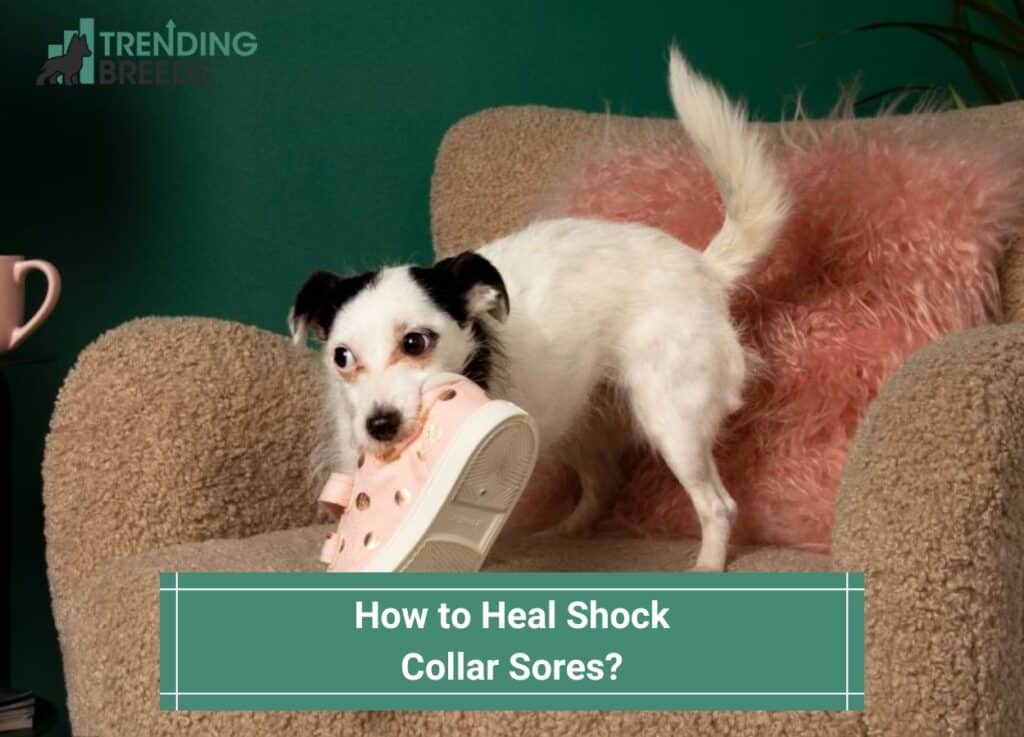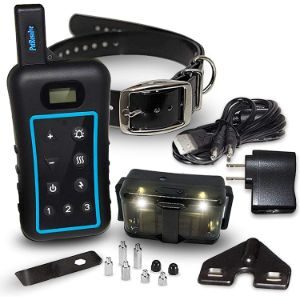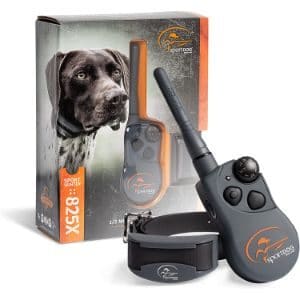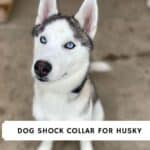
When people talk about shock collars, there’s always going to be a negative stigma. Concerns about shock collar training range from the ethicality of its use to the injuries owners see on their dogs during use.
We won’t say that shock collars are completely safe because misuse of these devices is the leading cause of problems both physical and mental.
Electronic collar use should not pose any life-threatening risks, unless you’re grossly negligent, and there is a ton of literature about shock collar safety practices on the internet that teach you the basics.
What Causes Shock Collar Wounds
There are three major reasons with the first two as the most common: Pressure Ulcers, Allergic Reactions, and Actual Burns.

Shock collar burns may actually happen, or at least there’s enough anecdotal evidence in the form of images that look like neck burns and hundreds of claims of it happening, so let’s assume it does happen. With that said, what are the causes?
1. Pressure Ulcers
Similar to bed sores, they happen when the collar is left on the dog for too long with the proper tightness, or was placed too tight for a certain amount of time, or when you place a leash on the collar receiver itself.
The excessive pressure exerted by the prongs on the skin will restrict blood flow and suffocate the skin cells little by little, leading to pressure necrosis where the cells die off.
The dead tissues create an opening for the prongs to dig into the next layer of skin and this keeps on going until there’s not enough pressure to cause more skin layers to die off.
This creates an opening for a bacterial infection to occur, leading to severe inflammation and pus that causes hair loss and creates brownish coloration. This coloration, damage, and the hole it makes could be mistaken for burn wounds.
2. Allergic Reactions
Just like how people can have allergic reactions to certain metals and chemicals, so do dogs.

Some shock collar prongs, especially low-quality ones, have prongs coated with certain metals to prevent rust like nickel instead of hypoallergenic coatings like good’ol stainless steel.
The symptoms can appear as Lesions on the skin, hair loss, change in skin pigmentation, skin irritation, and redness, and eventually skin infections from the lesions.
The effect would look quite similar to pressure sores and sometimes, these allergies cause pressure necrosis to occur much faster.
3. Shock Collar Burns
Normally, high-quality shock collars would never cause a burn because the device is not capable of delivering enough energy or joules to cause a burn, even if you hold down the shock button.
Even then, good quality shock collars have a limit to how long the static shock will go when you hold the button, usually less than 10 seconds.
If you ask if it produces heat, it does, but only technically since any form of electrical energy running through metal will produce some kind of heat through resistance.
The strongest shock collars deliver an average of 0.0005 Joules, barely a millijoules per “Nick”, and “Continous Shocks” from these devices don’t deliver a steady stream of electricity, but rather a series of these millijoules-weak nicks.
The average “Abdominal Energizers” a.k.a those devices that promise slimmer tummies in 5-6 weeks, deliver a much stronger 0.01 joules of energy, which still isn’t much, but is significantly stronger than shock collars.
As an extreme example, a commercial taser delivers anywhere around 1.76 to 0.36 Joules, and a defibrillator delivers anywhere between 120-200 Joules. So, compared to a standard taser, a shock collar’s electric shock is roughly 1000 times weaker.
We’re saying this because it’s near impossible for these electric dog collars to cause a burn. The two other problems are far more likely to occur and cause worse problems.
However, we didn’t say it’s completely impossible.
There may be a chance that low-quality electric dog collars could have a faulty component that makes the transformer output far more energy than it should, and we have ways to test it before you even put it on your dog.
If you’re considering getting an electronic collar, get one from a reputable brand, or with significant reviews. It never hurts to do a bit more homework, especially on a product you’re going to spend your good money on and that may have a chance of hurting your dog.
How to Treat Shock Collar Sores
Most of the time, these injuries are minor, but that doesn’t mean you can let them be. There are various ways you can do first aid on shock collar wounds to help relieve them of some discomfort and speed up the healing process.

These are step-by-step procedures depending on how severe the damage is. If it’s minor, you can stop and step 1, and keep going depending on what you see.
1. Remove the Collar, Clean the Wound, and Clean the Receiver
This is the most important step, and if the pressure sores haven’t caused pus, significant inflammation, and fur loss in the surrounding area, you can simply clean the wound with warm water.
You can use a warm washcloth and press it on the wound for a few minutes. Afterwards, let it dry and keep it dry for a while. Light wounds and shock collar marks will resolve and recover on their own in a couple of days.
The same applies for shock collar burn treatments but if the wound has progressed, proceed to step 2.
2. Apply an Antiseptic Solution and Bandage on the Wound
If there are visible wounds or ulcers present, you need to clean the collar sores and apply an antiseptic to prevent any infections from taking root.
There are a lot of options you can use, but out of all of them, don’t use alcohol because it will make the wound worse in the long run and would be painful for your dog.
You can use natural solutions like Tea Tree Oil, Aloe Vera Gel, or even Honey directly on the wound after you cleaned it. Other effective chemical antiseptics are Povidone-iodine aka Betadine Solution, Chlorhexidine, or Hydrogen Peroxide.
Alternatively, you can use an Antiseptic soap to clean the wound, which are soaps that contain triclosan or triclocarban. You can also place some petroleum jelly on the wound to protect it from dust and bacteria.
Afterwards, let the wound dry and apply anything that can cover the wound like gauze or any small bandage. You may need to trim or shave some of the surrounding hair to allow the bandage to stick.
3. Use an Antibacterial Ointment after an Hour and Over-the-Counter Pain Meds if Needed.
If the wound has a lot of pus, bad odor, and significant hair loss around the wound, you need to follow all the steps above to clean and disinfect the wound then let it dry while covered.
After a while, when it’s dry, you should apply an antibiotic ointment on the wound to prevent further infection and leave it covered.
Clean the wound with warm water, reapply any topical antibiotic as the instructions state, and observe your dog’s behavior.
If you see signs of pain like agitation, irritation, your dog not wanting you to touch the area, or mildly aggressive behavior, consider giving them pain medication.
4. Observe your Dog for a Day or Two and Take Them to the Vet if Needed
Check on the wound every 6 or so hours and see if it’s showing any signs of recovery such as reduced inflammation or if the wound is starting to dry up and create scabs.
If the skin redness or hair loss is spreading, or the wound is producing more puss, take them to the vet for a physical examination, and give your dog antibiotics or mild surgical treatment to help the wounds close.
How To Prevent Shock Collar Wounds
Now that you know how to treat shock collar wounds, you should also know how to prevent them. We have two common causes and one rare cause, but all of these measures should minimize or downright prevent these injuries from happening.

1. Don't place a lead/leash on the collar receiver like a regular collar
Though some of the plastic straps have that ring where you can place a lead, don’t place one on it. If you need to place a leash on your dog, place a regular collar on them and a leash.
You may crowd your dog’s neck if you have a breed with a shorter neck, but not using a separate collar can cause inconsistent shock, and pulling on the lead the wrong way could make the prongs put excessive pressure on their neck.
Which could speed up the symptoms of pressure sores.
2. Use the correct tightness and prongs
A tight collar is important because the prongs need to consistently touch your dog’s skin for it to have any effect. But you can’t place it too tightly that you’d cause pressure sores in less than an hour.
To find the correct tightness, place 2 fingers between your dog’s neck and the strap and tighten it until it’s just snug enough to slide your fingers out with some resistance. If you have a small dog, use 1 finger instead.
Most electronic collars come with 2 metal prongs with different lengths, and some come with a 3rd extra long prong or a C-shaped spring steel prong. If your dog has longer fur, then use longer prongs.
Check if the prongs make proper contact with the skin when you do. You can wiggle the reciever a little to let the prong dig into the fur.
If your kit doesn’t have the extra long prongs or the spring steel, you need to trim their fur around their neck a bit. Don’t shave it completely though.
3. Always test the receivers and don't use shock on the first day
All electric dog collars, even the automatic bark collars have a small plastic tester you can use to check if the receiver is delivering the shock properly.
The small LED in the tool will glow brighter the stronger the shock is, and you can quickly tell if the receiver is malfunctioning if the tool lights up without any remote pressing.
The tiny LED will glow really bright if your receiver happens to be delivering a stronger shock than it’s supposed to, which can avoid potential shock collar burns.
Test your kit everytime you’re going to place it on your dog, it only takes less than a minute.
Almost all “How to Train your Dog Using a Shock Collar” articles and literature will tell you not to use the shock on the first 1-2 weeks of training, and instead, just let them wear the it as normal.
This keeps your dog from being collarwise and it will also let you know if your dog is allergic to the metal on the prongs. If you don’t want to risk an allergic reaction but still want to use the kit you have, consider buying silicon caps for the metal prongs.
They are thin enough to conduct the shock, but some people report that it weakens the shock strength a bit.
4. Do not leave the collar on your dog for more than 8 hours, and rotate it if you can
This is one of the leading causes of advanced pressure sores, which leads to people trying to find ways on how to treat shock collar wounds, and sometimes mistake it for burn wounds because of the unique hole-shaped wound.

It’s common for trainers and owners to leave the training collar on their dog way after training. It keeps your dog from making the association that training time is linked to the shock collar.
Some dogs are smart enough to make that link and only be obedient when they are wearing it. Some recommend not leaving it for more than 6 hours, some more than 10, but the point there is to not leave it on your dog for too long.
If you really need to keep the receiver on for longer, like when you’re out hunting the entire day, you can rotate the receiver on their necks so the prongs press on a different part of their neck. You can do this every 1-2 hours.
5. Buy good quality shock collars
As easy as that is to say, buying the correct collar is difficult unless you already know what you’re doing. Some of them are expensive, reaching $250 and higher with certain “moderate” features, only to find kits under $70 having similar features, sometimes even higher.
It’s safe to say that the products above the $100 mark (outside of sales and discounts) have dependable quality.
Read the reviews and check the 1 and 2 star reviews about it first to see the glaring problems, then read the 3 star reviews which often contain the most insightful information about collar usage.
If the price is affordable but and has the same features, corners were cut somewhere, either on logistics, materials, production, or quality control, or all of the above.
If you’re interested, we have a small list of shock collars we highly recommend. You can also use them as a comparison when you’re trying to find the perfect electronic collar to suit your needs.
These are guaranteed to not cause shock collar sores in your dogs as they’re tried and tested by us.
Recommended Dog Shock Collars






- Pros
- 3/4 Mile Range
- Built-In Bark Limiter
- Comes with 2cm Extra Long Metal Prongs
- Remote-Activated LED Tracking Lights
- Includes Plastic Prongs for No-Shock Mode
- Cons
- Does Not Go into Standby Mode
- Won't Fit Dogs Below 15 lbs.
We start with the training kit that has the best value for its features. With all its features taken into account, it’s a pretty standard shock collar that can be used for basic and advanced training and even hunting while still being beginner friendly.
It has 10 levels of electric stimulation and vibration with a hearing-safe beep. The remote has a huge range to compensate for signal loss when you’re in places with heavy foliage and trees.
The tracking LEDs help you spot your dog in the dark and while it’s not a very bright light, it can strobe so your eyes can spot it even a hundred meters away.
The remote can be paired with up to 3 receivers and you’ll need all the range you can get when you’re handling 3 dogs in a wide open space.
The anti-bark function is simple but effective. When you turn it on, it will listen and feel for your dog’s barks. When it hears it, it will beep for 2 seconds.
If your dog doesn’t stop barking, it will trigger a shock based on the level it was on when you turn the feature on. If your dog keeps barking through it, it will keep going for 8 consecutive “nicks” before resting for 2 minutes.
The receiver is waterproof, the remote is rain-proof, and both have an average battery life of 50 hours. It does not go on standby mode, so as long as it’s on, it will be active and responsive until your turn it off or it runs out of batteries.
In case you have a dog with long fur, you can use the 2cm prongs to avoid having to trim their hair.
If you want all the features but without the shock, you can replace the prongs with the non-conductive plastic ones to completely avoid pressure sores and potential shock collar burns.
- Pros
- 1/2 Mile Range
- Unique Button Set-Up for Quick Shock Level Change
- High Waterproofing for Both Remote and Receiver
- Cons
- Does Not Go into Standby Mode
- Won't Fit Dogs Below 15 lbs.
Our next recommendation is an optimal pick from SportDog’s line of outdoor and advanced training collars. The remote has a unique button setup where it has a dial with 7 levels that you can freely flick with your thumb back and forth.
You also have three shock buttons that deliver strong, medium, and weak shock respectively.
With this, you can deliver certain levels of stimulation within a second or two, useful if you are training a dog with high chase-drive or prey-drive and you need to interrupt a potentially dangerous behavior.
It’s not exactly beginner friendly, but once you get the hang of it, it’s great for both training and outdoor activities. To further its use outside, both devices are waterproof for up to 25 feet for 30 minutes.
It practically ensures that water damage will be the least of your worries.
This one has less features compared to our first, but focuses on the quick level-changing technique you can develop while using it, and the higher waterproofing.
- Pros
- 1/2 Mile Range
- 100 Levels of Shock
- Shock-Boost Button
- Remote-Activated LED Tracking Lights
- Cons
- Does Not Go into Standby Mode
- Won't Fit Dogs Below 10 lbs.
Our final recommendation is for trainers and owners who want to use the absolute lowest shock stimulation level as possible that will work on their dog.
This remote has a rheostat, a dial that freely controls the electrical resistance from minimum to maximum. It’s similar to volume knobs on most devices except it’s for the static stimulation.
This means you can’t quickly change the level because you will sacrifice some precision. To compensate, it has a shock boost button.
It’s a shock button that delivers a stronger level shock than the current level. up to 20 levels, opening up the potential for advanced training, or training in environments with plenty of distraction.
The remote controller is only rainproof but it floats on water, giving it some level of practical waterproofing. The receiver has the standard IPX7 waterproofing, resisting up to 1 meter of water.
With a battery life of around 40 hours, as long as you turn the collar off every 8 hours, or when not in use, the battery will last a week before it needs a recharge.
Conclusion For "How to Heal Shock Collar Sores"
Finding ways on how to heal shock collar sores is just as important as preventing them from occurring. Simply being aware of these problems and their causes is already half the battle won.
The rest is practice and effort. All tools have their own pros and cons, and while shock collars are arguably the most effective tool in reinforcing important behaviors, it also has its fair share of risks.
You don’t have to use these devices, but if you do, remember to place your dog’s wellbeing above all else. Training is a long process and you’re better off doing everything bit by bit than in large strides.
You can learn more about dog shock collars by watching “Negative Effects Of Shock Collars” down below:
Last update on 2024-05-02 at 13:22 / Affiliate links / Images from Amazon Product Advertising API






